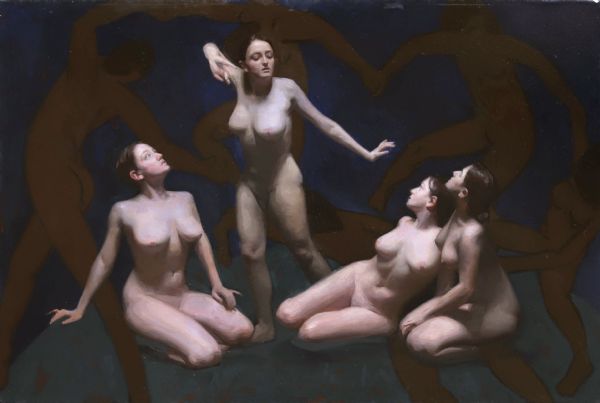Giotto Riva is a painter living and working in Milan, Italy. Having devoted himself to the study of painting from childhood and attending specialist art schools as a teenager, he trained in classical, figurative painting at the Barcelona Academy of Art, studying under director Jordi Diaz Alama for four years. Here he completed the advanced program in drawing and painting, approaching it through rigorous study of human anatomy, light and form, chiaroscuro, and painting techniques through the analysis of the great masters.
Painting from life, photographs, sketches and preparatory drawings, rendered mostly on linen using oils, Riva’s paintings range from baroque, dramatically-lit nudes to delicate portrait studies, still lives and social snapshots. Though he doesn’t shy from the inclusion of overtly contemporary references (the striped decal on the side of a truck, modern labels wrapped around beer bottles, iPhone laying face-down nearby a lingering hand with a cigarette), there is something of the distant past in Giotto’s subtle, deft attention to technique that overrules them, falsely implanting them as legitimate props in a long-lost memory. Indeed, he describes himself as fascinated by the realism of the late 19th and early 20th centuries, and enamoured with the rebellious spirit of the French post-impressionists and the 19th century Italian Scapigliatura movement. There is a similar quiet promise of bohemian decadence in Riva’s works.
The use of such strong historical technique is deliberate. In his most recent work 'La Danza', three nude figures are positioned on the floor, gazing up at a fourth who appears frozen in a dramatic retelling of a story, monologue, or dance. The figures’ expressions flit from worry to wonder, their body language attentive but poised, uncertain. Behind them in near darkness lurks a recreation of Matisse’s Dance, a homage by Riva to the vastness of the painter’s practice and to an environment of child-like innocence that this work invokes.
In an interview with Artrights, Riva describes a push in Barcelona and New York to utilise classical painting and sculpture in order to address “modern and contemporary themes through the technical and stylistic research of the ‘beautiful' […] people have returned to need something concrete in which to reflect [their surroundings], a type of painting in which to see each other again, find themselves and no longer get lost.” He continues, “I believe that every man lives his life through an infinite number of constantly changing sensations, thoughts and emotions. The painter's skill lies in grasping these sensations and trying to give them to the observer. I believe that in painting there must be a lot of empathy between the parties’ you have to be willing to go deep and try to look beyond the image alone, creating a connection of spirit and thoughts with the observer.” (Artrights, 2022)
In 2019, Giotto received the University Prize at the Morlotti Prize and the second prize in the Painting category at the Artrights Prize competition. His works have been exhibited in Milan, Barcelona, and Rome and can be found in a number of private collections, including the Permanent Museum of Milan.
